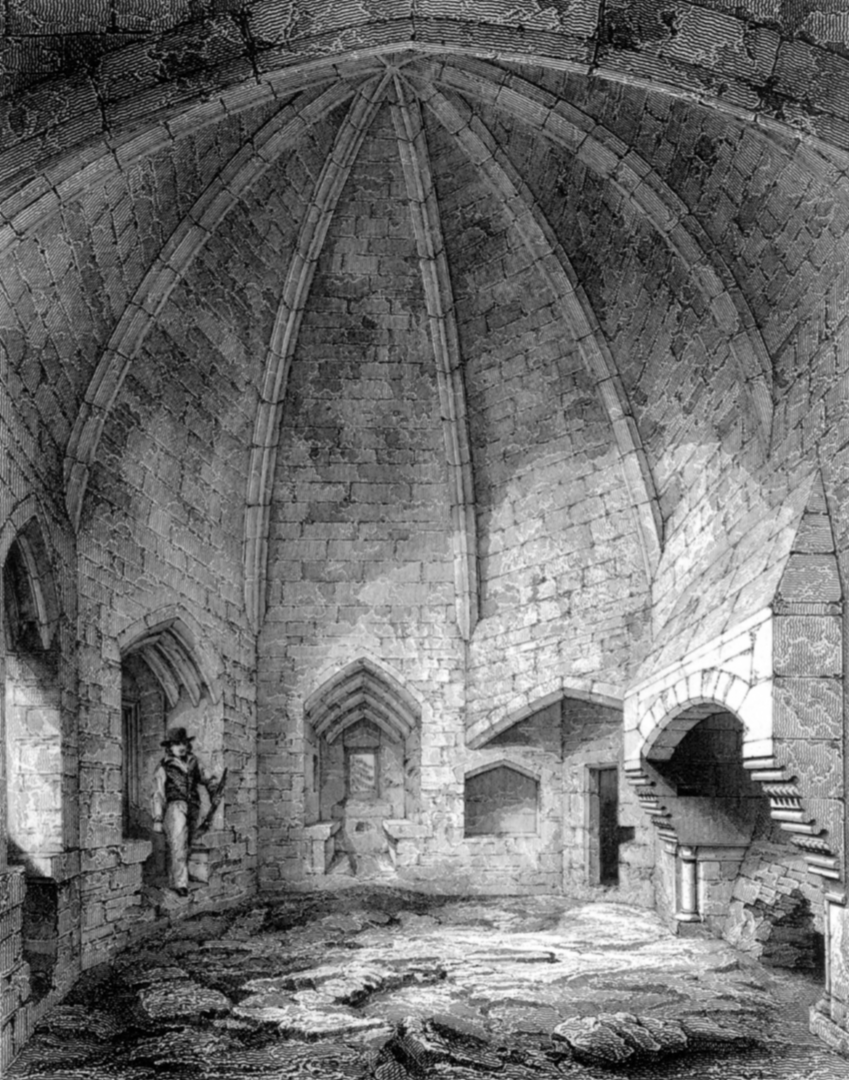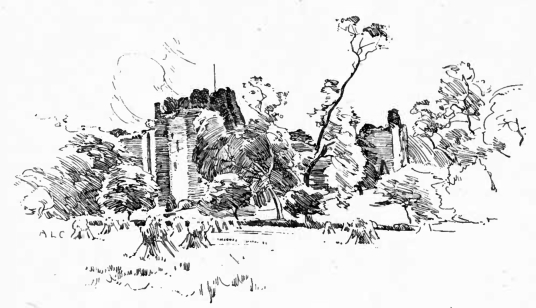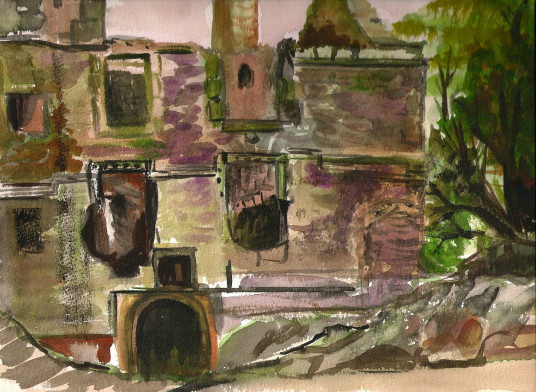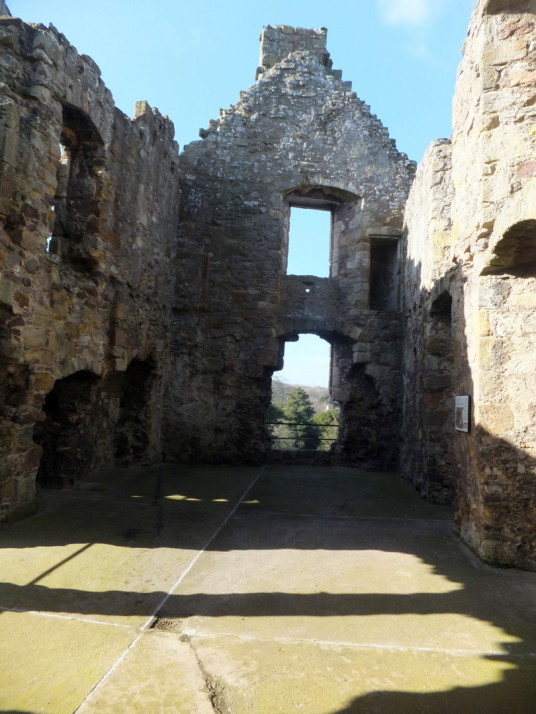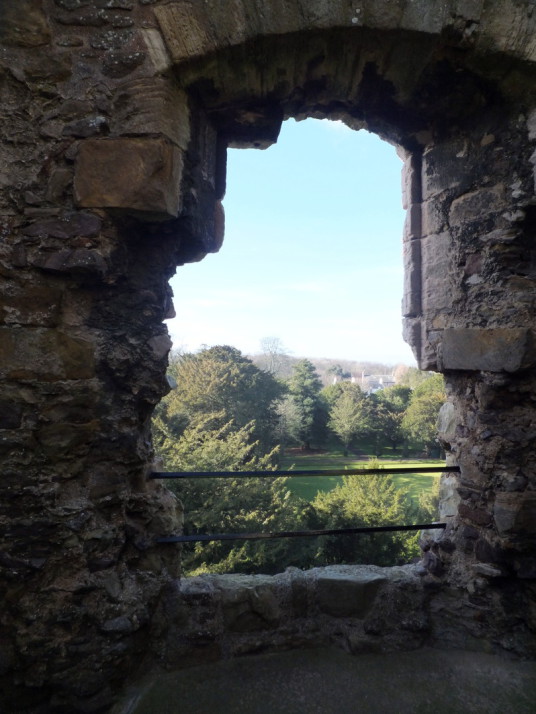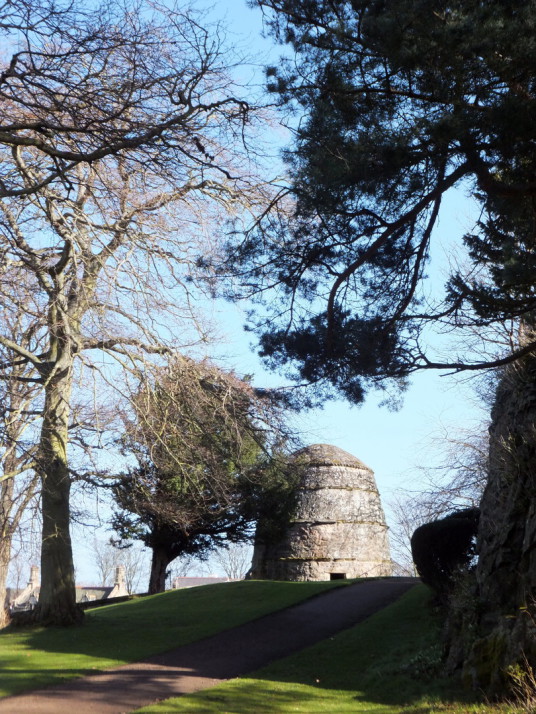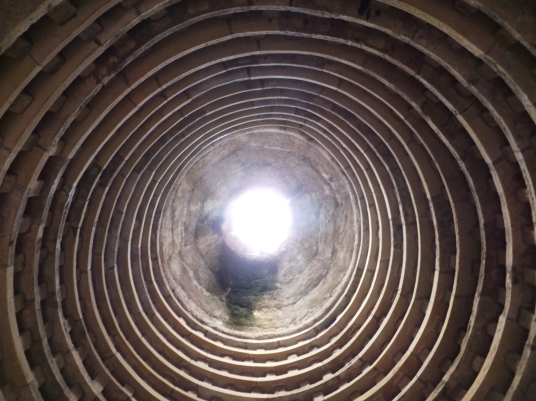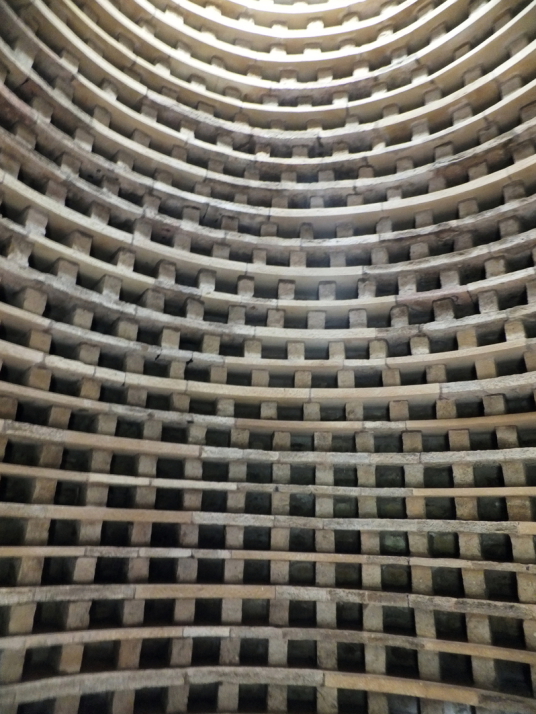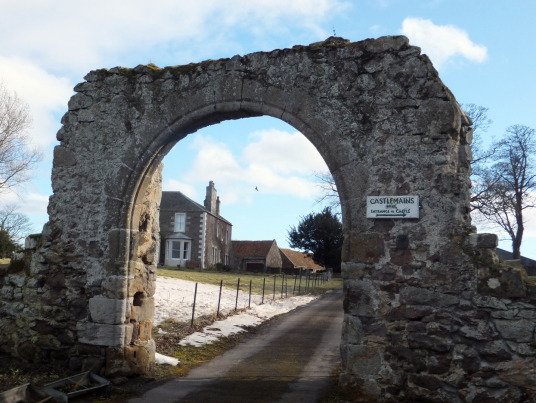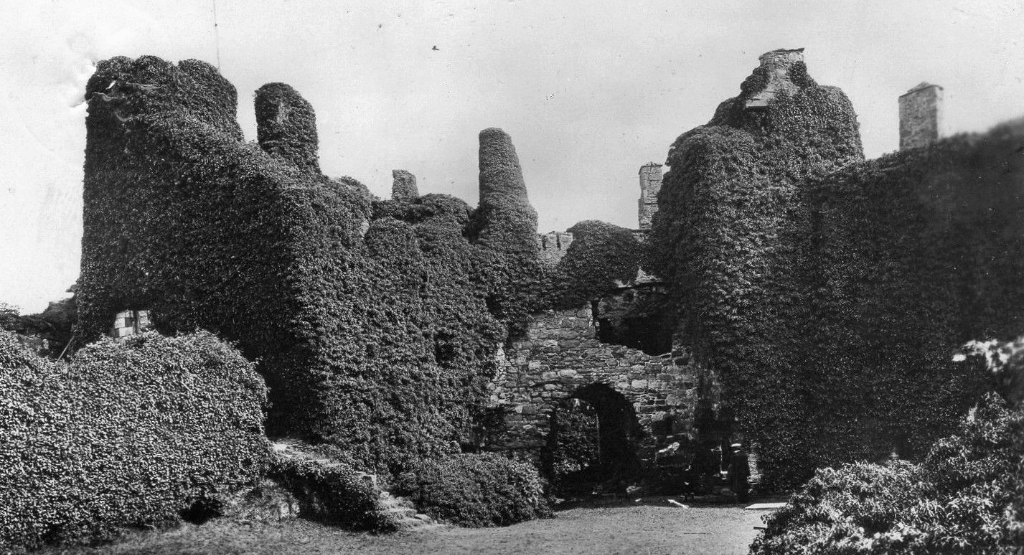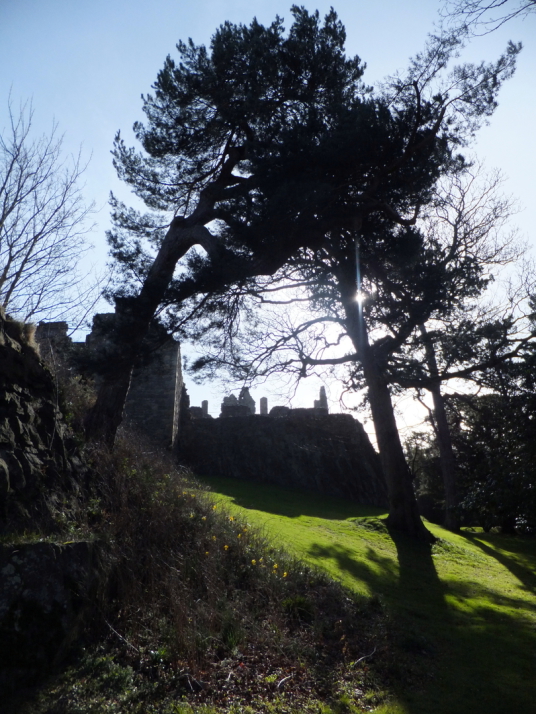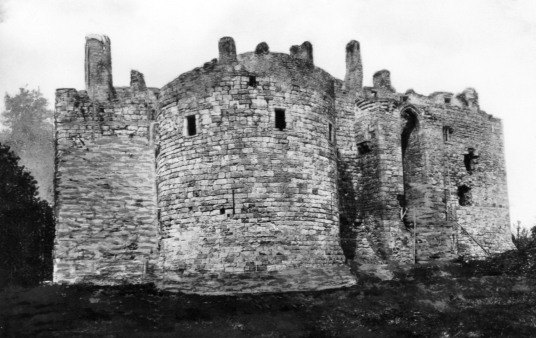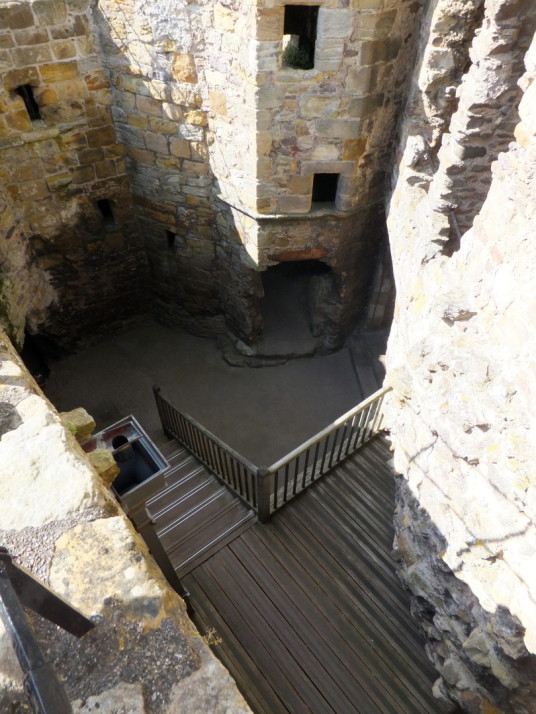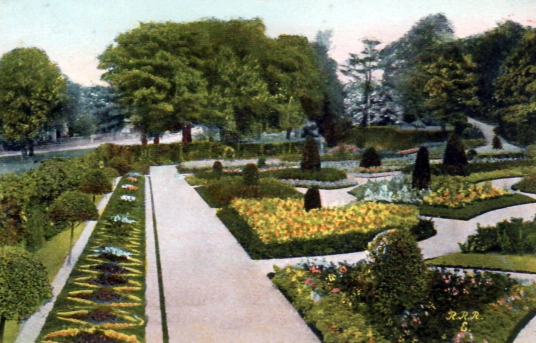–––––– Castle of the Month August 2017 ––––––
Dirleton Castle
In the heart of the pretty village of Dirleton, the castle is a large and imposing ruinous medieval fortress, set in beautiful gardens and grounds, with many atmospheric chambers to explore and finally besieged and partially demolished by Cromwell's forces in 1650.
Lothians: About 2.5 miles west and south of North Berwick, on minor roads north of A198, in Dirleton village, at Dirleton Castle.
HES NT 518840 OS: 66 EH39 5ER
OPEN: Open all year: Apr-Sep, daily 9.30-17.30; Oct-Mar, daily 10.00-16.00; last entry 30 mins before closing; closed 25/26 Dec and 1/2 Jan. Gardens. Weddings.
120 yard walk to castle. Shop. WC (carpark). Places to eat in the village.
Tel: 01620 850330 Web: www.historicenvironment.scot
Dirleton Kirk: open daily Web: www.scotlandschurchestrust.org.uk
Checked 5/4/18
Standing on a rock in picturesque grounds, Dirleton Castle consists of towers and ranges of buildings around a courtyard, which was once surrounded by a wide ditch.
The old part of the Dirleton Castle, dating from the 13th century, is grouped around a small triangular court, and consists of a large drum tower, a smaller round tower and a rectangular tower. The chambers in the drum tower are polygonal, one on top of the other. The basement is vaulted, like a dome, and has a fireplace decorated with dog-tooth mouldings.
The upper chamber would probably have been the lord’s hall or room, and is a particularly fine apartment with a high ceiling and window seats. Two further towers stood at corners of the courtyard, but these have been reduced to stumps and replaced by or incorporated into later building.
The entrance to the castle is by a wooden bridge across the wide ditch, and is through a gatehouse dating from the 14th and 15th centuries, formerly with a drawbridge and portcullis and protected by a murder hole.
On one side of the castle is a 14th-century range of buildings with a very thick outer wall. The basement, partly dug out of solid rock, contained the bakery, with ovens and a well, and several large vaulted cellars. Above the bakery is the kitchen with two huge fireplaces and a service room leading to the hall.
Above the bakery is the kitchen with two huge fireplaces and a service room leading to the hall.
The hall, on the first floor and now reached by a modern wooden stair, although now very ruinous was very large, and one end is raised and was probably screened or was a separate chamber. A unique carved buffet has been reset into one wall.
A stair linked the hall and cellars at one end, and at the other a stair led down to the chapel and priest’s room, below which is a dungeon, beneath which is a dark pit-prison. There were further rooms above the end of the hall but the layout is far from clear.
In the 16th century a further three-storey range (Ruthven) was added within the courtyard. This block has large windows with shot-holes beneath and a string course decorating the upper storey. Two large turnpike stairs gave access to the upper floors, while a pend leads through the range to the small internal courtyard.
A stair leads down from the courtyard to the former gardens, now a bowling green surrounded by yew trees.
There is a fine beehive doocot, dating from the 16th century, near the castle with more than 1,000 spaces for birds, and the original entrance now outside the perimeter wall.
The original gateway [NT 516840] into the outer courtyard of the castle survives, probably dating from the 16th century although now outside the current perimeter wall and only giving access to Castle Mains farm. The original wall surrounding the building has gone.
‘Dirltoun’ is marked on Blaeu’s map of The Lothians in an enclosed and wooded park, while ‘Dirletone C.’ is depicted on Adair’s map of East Lothian.
The lands were held by the Congilton family in the 12th century before passing to the De Vaux family about 1150, and the castle was built in the 13th century, although there may have been an earlier stronghold on the site. Dirleton was captured by the English after a hard siege in 1298, when large engines were used. The garrison were allowed to retire with their goods. The castle was retaken by the Scots in 1311 and partly demolished, but was rebuilt and was seized by the Earl of Douglas in 1363.
In the second half of the 14th century the castle had passed by marriage to the Halyburton family, who extended it and rebuilt much after damage during the Wars of Independence. Walter Halyburton of Dirleton is on record in the 1430s, then George Halyburton of Dirleton in the 1460s and 1470s, then James Halyburton, Lord Dirleton, in 1496. James IV visited in 1505. The line ended in three daughters, and the eldest Janet married William Ruthven, 2nd Lord Ruthven, in 1515, and the castle passed to the Ruthvens.
Janet and William’s son, Patrick Ruthven, 3rd Lord Ruthven, was one of those involved in the murder of David Rizzio at the Palace of Holyroodhouse in 1566. Patrick fled to England and died there, while his son, William Ruthven, was made Earl of Gowrie in 1581. He was instrumental in the Raid of Ruthven, when the young James VI was held in what is now known as Huntingtower Castle, formerly known as Ruthven Castle. James VI escaped and although Ruthven was pardoned he was beheaded in 1584 for plotting to seize Stirling Castle. The property was eventually restored to John Ruthven, 3rd Earl of Gowrie. The Ruthvens added and remodelled the caste.
John and Alexander his brother were summarily slain by James and his followers in 1600, following the Gowrie Conspiracy (see Huntingtower) at Gowrie House in Perth, and the lands and barony were annexed to the Crown, the lands were acquired by Sir Thomas Erskine of Gogar, captain of James VI’s guard.
Erskine sold the property to the Douglases, who sold it to the Morrison of Prestongrange, who in turn sold it to Sir James Maxwell in 1631. He was made Earl of Dirleton in 1646, but the title became extinct on his death seven years later. In 1649 several women and men, who had confessed to witchcraft after the witch-finder, John Kincaid, had found ‘devil's marks’ on them, were imprisoned in the castle, later to be strangled and burned at the stake.
In 1650 the castle was besieged by General Monck, during Cromwell’s invasion of Scotland (also see Tantallon and Innerwick). A party of mosstroopers had been attacking Cromwell's lines of communication, with some success, but they were quickly forced to surrender. Three of the leaders were subsequently shot. The castle had been damaged in the attack, and was probably slighted and partly dismantled.
Sir James Maxwell had two daughters, the title becoming extinct on his death, and the property went to his grandson, who sold it to Sir Robert Fletcher in 1658. In 1663 the property was bought by Sir John Nisbet, when the castle, tower, fortalice, manor place etc are mentioned, and he built (or rebuilt) the house of Archerfield [NT 505841] around the end of that century to replace the castle. The castle then became a landscape feature in the wider policies of Archerfield.
Dirleton Castle was given to The National Trust for Scotland in 1981 and is in the care of HES.
There are fine gardens with ancient yews and hedges around the bowling green, laid out in the late 1800s and early 1900s by Mary Nisbet, Countess of Elgin, as well as a exceptionally long borders (believed to be the longest herbaceous borders in the world) in the fine early 20th-century Arts and Crafts garden, and a recreated Victorian garden. In the gazebo, a corner tower by the entrance, is a museum about the castle and gardens. The perimeter wall dates from the late 19th century.
Dirleton is a pleasant village around a wide green, and Dirleton Kirk dates from 1612, being moved here after the old church at Gullane was inundated with sand from the beach. Village website.
The Archerfield (or Dirleton) Aisle, with neoclassical designs and thought to be the first in Scotland to be so decorated, dates from the 1650s, and was built to house the grave of Sir James Maxwell, 1st and only Earl of Dirleton (also Dirletoun), built by his wife Elizabeth Buson de Podolsko or de Boussoyne or Debousy (or other spellings) for a sum of £45.
The village has two hotels/inns (The Castle Inn and The Open Arms) as well as a cafe (Amalfi).




